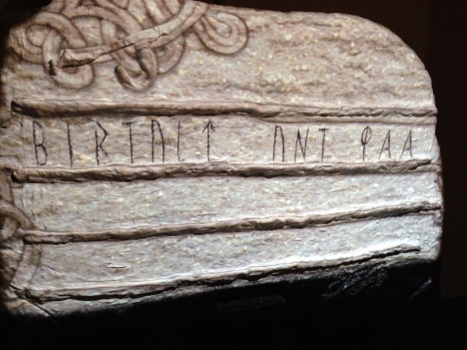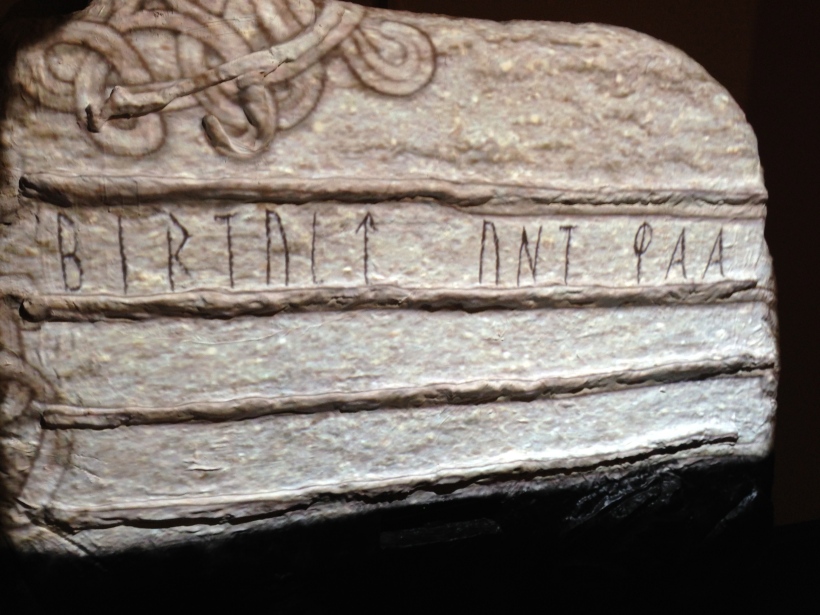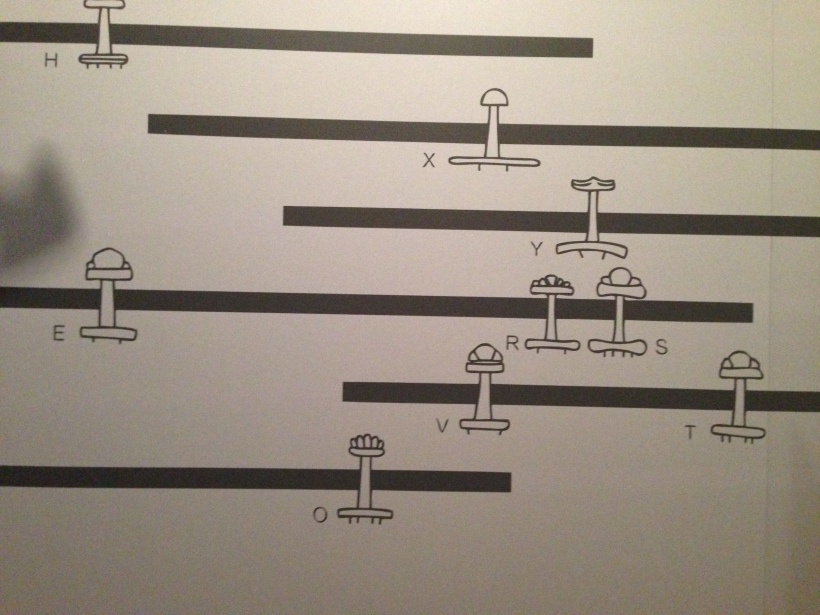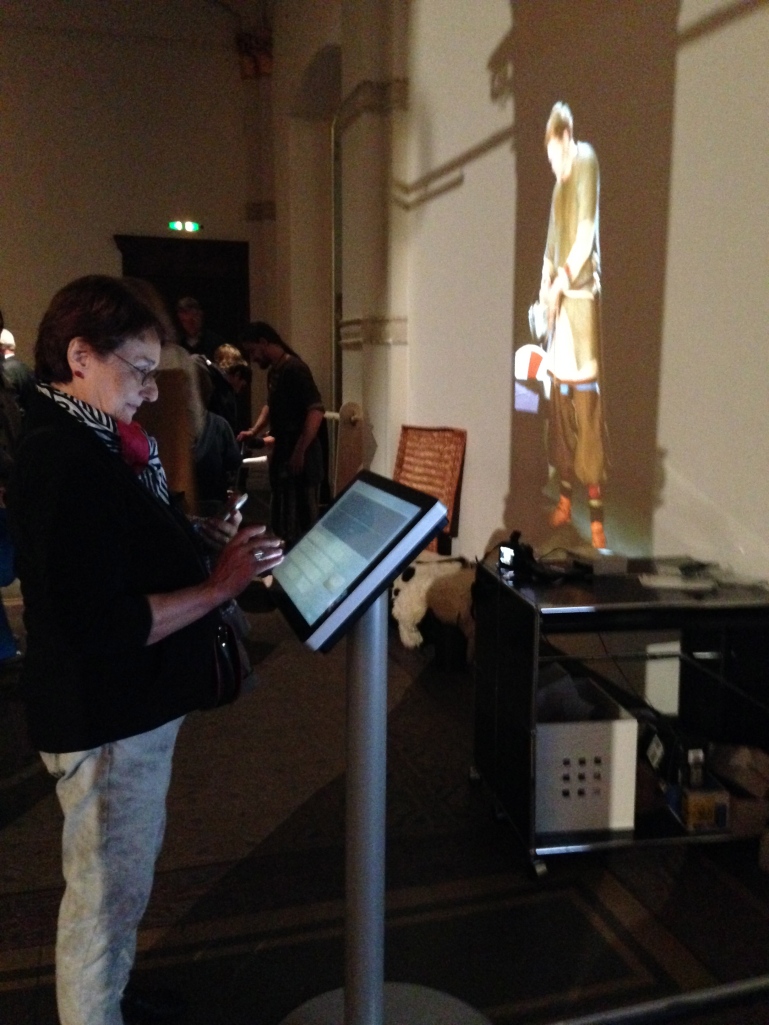“Die Wikinger” ist in Berlin angekommen. Spätestens mit der Ankunft des Seehengstes von Glendalough am 7.9.2014, der von einem größeren Publikum v.a. mit Kindern begleitet wurde, stieg der Hype um die Ausstellung im Gropius-Bau noch einmal an. Mit der Ausstellung “begeben sich die großen Museen dreier europäischer Kulturmetropolen auf die Spuren der sagenumwobenen Nordmänner” (Eigenauskunft der Website).
Aber eigentlich stand für mich nicht das Schiff im Vordergrund, obwohl dies lt. der Website der große Fokus sein soll, mir fiel von Anfang auf, dass hier wohl multimedial gearbeitet werden soll. Bei Ankunft des Schiffes erhielten wir Besucher von Wikinger-Reenactment-Menschen Flyer mit Infos zu einer Ausstellungs-App, die man mit oder ohne Museumsbesuch spielen könne, es gäbe einen zweiteiligen Dokumentarfilm namens “Die Frauen der Wikinger” und zu guter Letzt ein Onlinespiel. Und natürlich die Ausstellung! Alles in allem eine gute Eigenwerbung für die Firma Gebürdet Beets, die Ausstellung medial begleitet.
Zunächst schaute ich mir vor dem Austellungsbesuch einen Teil der Dokumentation an und möchte eigentlich nicht viel dazu sagen, außer dass da viele blond bezopfte Frauen sich gegen ihre unsensiblen Männer stellen – das Ganze durchbrochen von Experteninterviews und Archäologen, die “überraschende Funde zu Tage fördern” und “mit verschiedenen Disziplinen zusammenarbeiten” um “den neuesten Stand der Forschung” zu präsentieren. Positiv war immerhin, dass hier auch mal Archäologinnen interviewt waren, das ist ja sonst eher ein seltenes Phänomen. Ansonsten verweise ich auf eine recht treffende Rezension des SPIEGEL mit dem schönen Titel: “Weib, mach das Horn recht voll!”.
Also dann die App. Ja, die App. Mir war nicht recht klar, an wen die sich richtet. Da ich auf dem Flyer geduzt wurde, dachte ich, das könne vielleicht auch für Jugendliche oder Kinder (?) gedacht sein. Die Information auf iTunes behauptet an erster Stelle, es handele sich um “Rätsel-Spaß für die ganze Familie“. Das ist definitiv nicht ganz richtig…. ich würde hier eher “für Menschen ab 14” angeben, alleine schon aufgrund der Fragen und der Sprache. Ansonsten ist das Ganze ganz niedlich, sehr informativ und man kann am Ende gewinnen und Clanchef sein oder auch an einem Gewinnspiel teilnehmen. Und man bekommt sehr schöne Fotos der Highlights der Ausstellung bereits vorab, plus viele Hintergrundinformationen zu ausgewählten Objekten in der Schatzkiste, die man während des Quiz befüllt.
Dergestalt vor-informiert ging ich zur Ausstellung. Mit Kind. Da ich selber immer noch keine Audioguides mag, das Kind sie aber liebt, besorgten wir die Kinderführung und: los gings!
Allerdings – es geht nicht gleich los. Denn wie in vielen Ausstellungen soll man zwar theoretisch einem Rundgang folgen, findet den aber nicht gleich. Weswegen das Museumspersonal im Eingangsbereich immer wider die gleiche Frage hörte. Zudem sollten wir ja dem Audioguide folgen, bei dem bereits die allererste Station unauffindbar war. Wir haben die “1” bis zum Schluss nicht gefunden. Aber gut, das Gesuche nach den Auduioguide-Nummern kenne ich mittlerweile und mag es trotzdem nicht.
Da ja der Fokus der Ausstellung das Schiffsmotiv war, prangt sofort im ersten Saal das Roskilde 6- Schiff. Es ist wirklich riesig, das Segel erfüllt den gesamten Lichthof und natürlich ist es unglaublich imposant. Da hätte man schon was mit machen können, nur leider ist es so, dass die Ausstellung sich ganz stark auf wunderhübsche Objekte bezieht, die aber nur ganz wenig Hintergrundwissen vermitteln. Liest man wie ich die relativ kurzen zweisprachigen Begleit-Tafeln, dann erfährt man ein bisschen was, aber der Bezug zu den Objekten, den gibt’s nicht direkt. Denn da steht eben nur: Scheibenfibel, Mammenstil, und eine Jahreszahl. Aha, denkt man sich. Ist ja schön. Was ist denn der Mammen-Stil? Warum wurde diese Fibel ausgewählt??? Und dann geht man weiter.
Wie gesagt, ich benutze keine Audioguides. Ich möchte eine Ausstellung erleben ohne dass mir jemand vorgibt wie ich laufe, wie lange ich schaue etc. Vielleicht ist das ein Fehler, vielleicht muss man heutzutage einen Audioguide nehmen. Ich bin da wirklich altmodisch, ich denke es sollte auch ohne wirken UND informativ sein können. War´s in diesem Falle eher nicht. Denn das Dilemma zog sich durch die gesamte Ausstellung. Sicher, die einzelnen Bereiche waren farblich und ausstattungstechnisch voneinander abgesetzt. Jeder Teil hatte seinen eigenen gefühlten Bereich, eigene Farben, eigene Materialien. Das ist jetzt der große Knaller in vielen Ausstellungen, seien es “Die Irokesen” in Berlin oder “INKA” in Stuttgart. Jedes Unterthema soll auch unterbewusst auf den Besucher wirken.
Reell sieht das aber so aus, dass sich im Saal “Götter & Rituale” alles um einen kleinen runden Tisch mit unglaublich kleinen Objekten drängt, während dahinter eine 4 Meter hohe Videoleinwand Platz wegnimmt, um darauf rauschende Bäume und Himmel zu zeigen um Atmosphäre zu schaffen. Gleich daneben: “War & Conquest”. Ein Waffensaal, der mit mehreren Dutzend Vitrinen voll ist und dann keinerlei Info dazu, außer einem Haufen Schwerter, Steigbügel und Messer – und das alles so eng dass man sich fast auf die Füße tritt: was soll das dann? Alleine zu den Ulfberht-Schwertern könnte man sicher eine ganze Ausstellung machen! Zu allem Überfluss prangten überall die gleichen, wissenschaftlichen, super drögen Aufschriften der Objekte, sogar eine Chrono-Typologie-Tabelle habe ich entdeckt. Ohne jeden Text dazu. Dafür gabs bei den Waffen zum Beispiel diesen: “zweischneidiges Schwert des Typs H (nach Petersen), ehemals streifentauschiert.” . Was soll mir das sagen? Mir sagts nämlich gar nix. Was ist Typ H? Warum ist der wichtig? Wer ist Petersen?
Ganz ehrlich, liebe Macher, da ist selbst der Archäologe in mir (und sogar der TYPOLOGE) seufzend weitergegangen.
So zieht sich das also durch alle Säle. Ganz am Ende gelangten wir zur “Kinderecke”. Da konnte man sich verkleiden, Fotos von sich machen lassen und einen Text in einem Computer eingeben der dann in Runenschrift auf einen “Stein” projiziert wurde. Und wie meistens war hier am meisten los. Alle wollten, nicht nur die Kinder! Eigentlich ein Beweis dafür, wie sehr das Publikum gerne mitmachen würden, selber etwas er-fahren. So wie es jetzt war, hörte ich öfter Dialoge wie diesen: “Und, was is dis jetzt?” – “Weiß nich, aber sieht schön aus, wa?” – “Joah, schon tolle Kerle diese Wikinger!” .
Witzigerweise wurde diese Form der Darbietung komplett konterkariert durch eine wirklich winzige Ausstellung des Wikingerschiffsmuseums Roskilde ganz am Ende des Rundgangs. Hier schaffte ein Handwerker gerade in Handarbeit an einer Replik eines Wikingerbootes, ganz ernsthaft mit Hammer und Meißel. Die Ausstellung selbst ist natürlich auf die experimentalarchäologische Fragestellung des Nachbaus der Wikingerboote beschränkt, aber in ganz erfrischet Weise werden hier ständig Kontexte aufgezeigt wie in Sötten wie diesem: “Die Bootsbauer untersuchten welche Ressourcen (….) für das Langschiff erforderlich sein würden. Das zeichnete ein Bild der Gesellschaft der Wikinger und der MAchtstrukutern, die Voraussetzung dafür waren, die erforderliche Organisation und derart umfassende Ressourcen zur Verfügung zu stellen.” BÄM. In einem Satz steht hier, was in der großen Ausstellung lediglich anklang, aber nie klar gesagt wurde: Habe ein Objekt und du kannst mehrere Dutzend Geschichten zu der Gesellschaft dahinter erzählen.
Vielen Dank, dass das am Ende nochmal gesagt wurde. Nicht ohne Grund verweilten die Menschen hier, in diesem hellen Raum ganz ohne Objekte viel länger als in den anderen, mit berauschenden Objekten vollgestopften.
Alles in allem: noch weniger als vorher möchte ich wissenschaftliche Texte aus dem Katalog in der Ausstellung wiederfinden. Wer Interesse hat, schaut da drauf – das sind vielleicht 5 % der Menschen. Alle anderen gucken sich das an, findens hübsch und gehen nach Hause. Wollen wir das wirklich?
ENGLISH VERSION
„The Vikings“ have arrived at Berlin! Lately, the ship called „Sea Stallion of Glendalough“ arrived at September 7th and was accompanied by a lot of berlin families and children. This focussed the attention of the public even on more on the exhibition“ The Vikings“, to be seen at the Martin-Gropius-Building. According to the website „the great museums of three of Europe’s cultural capitals – Copenhagen’s National Museum of Denmark, London’s British Museum and Berlin’s Museum of Prehistory and Early History – set out in search of a people shrouded in myth: the Norsemen“.
For me, it was not the famous Viking ship that was in the foreground, although the website claims that the famous Roskilde 6 is the focus of the Berlin version of this exhibition, that could already be seen at London & in Denmark. What called my attention was the assumed multimedial focus of the exposition. When “Sea Stallion” arrived at Berlin, the marketing included flyers with information about a Viking quiz, a Viking online game, an app that accompanies the exhibition as well as a documentary on “The women of the Vikings”. All this came along the exhibition and it seemed to be a good marketing for the company of the Gebrüder Beets, who created all these gadgets.
So, before visiting the exhibition, I took an evening off and watched the documentary on Viking women – well, at least the first part. I wouldn’t say too much about this, its about a bunch of blonde women who fight their way against insensible men, interrupted by interviews with experts on Viking history and the ever so cliché archaeologist who “makes a great discovery” and “works in an interdisciplinary way to present the newest version of science”. Sigh. We all know how it works. Still, I would like to mention that at least there was some women archaeologists at the interviews, that’s something seldom found. Thanks for this, and for everybody else I would like to link to an article on the online paper of “Der Spiegel”, titled: “Wife, fill up the horn!” . That sums it up quite nicely.
And there was the app. Oh well, dear…. I couldn’t get it straight: at whom was this app directed??? I was approached on first name basis at the flyer so I thought that this was aimed at young people, even children? And when I consulted iTunes, it told me this was “mystery fun for the whole family”. Well, that’s simply not true. I would say that this is at least from 14 years onward, based on the language skills and the questions posed. Its relay nice, though, informative, nice photos, many of them of main objects of the exhibition, and you learn a lot. When you get to the end you win as being a clan leader, or you may apply to an online competition.
So, after this informative evening and thus prepared, we entered the exhibition. Me, and the 6-year-old son. Personally, I don’t like audioguides, so I got one for him (they have children version available) and went in without one myself.
But it doesn’t start at the beginning. Like in many exhibitions you get the advise to follow the tour – but its not easy to find the beginning of the tour. Should we turn right or left? Should we visit the Roskilde 6 first, which is presented at the centre of the enormous hall right at the beginning! Moreover, we should find number “1” of the Audioguide, which resulted in an imposible search. We didn’t find this number, never. Well, okay, So we just got on.
The focus for the berlin version of “The Vikings” was ships etc. So, following this, you will be confronted with “Roskilde 6” right at the beginning, its soooo big and it occupies all the space in this first exhibition room. But, and this is like a résumé of the whole exhibition: a beautiful object doesn’t make up for poor information. The whole exhibition is about beautiful objects, made from wood, from metal, from stone and whatever you like. But the information that goes with it, is sparse, short and very very dry. Its scientific. It reads like this: “Fibula with discoid catch plate, style so-and-so, YEAR”. That’s it. Oh great. What’s the so-and-so style all about???? Why did you choose this brooch to be on display???? And then – you just go on and forget about the brooch. And that’s the dilemma of this exhibition.
As I said, I don’t use audioguides. Maybe I should, maybe with an Audioguide this exhibition is great. But I like to explore an exhibition on my own, discovering objects and their meaning and their relationships and entanglements. And I still think that it should be possible to make an exhibition that works without an Audioguide, as well. And so, the exhibition was really nice. The separate sections on different themes were coloured differently and had their specific interior design that was thought to reflect the main theme of the objects. That’s the big thing right now, no matter if it was “The Iroquois” at Berlin or the famous “Inka” exhibition at Stuttgart this year. Every subsection is thought to have its won impact on the visitor.
But unfortunately, the reality looks like this: in the hall called “Gods & Rituals” everybody is crowded around a tiny round table that holds incredibly small objects related to deities. But in the background, a video screen with a height of an estimated 3 meters takes up ALL the space showing trees and skies to give us “the atmosphere” of the divine (I assume).
The opposite happens to the hall dedicated to “War & Conquest”. In a tiny hall, there are about 10-12 display cases, all painted in grey. They hold weapons, many of them in a very rusted stated or in pieces, that can only be seen from the front of every display. The displays are clustered so closely that you can’t barely move between them, you are continuously bumping into other people and the information you get is so sparse, it could make me weep. With the Ulfberht-swords alone you would have told a dozen of histories on Viking weapons and warfare, but you get information like this (quote): “double-edged sword of type H (after Petersen), formerly streifentauschiert” (translation mine and surely lacking). What´s that? What do you want to tell me? I didn’t get anything. What’s type H? what makes it relevant? And who is Petersen?
So, dear curators, I just went on and sighed. Even as an archaeologist (and worse: as an archaeologist who is into typologies), my patience had come to an end.
And so it goes on and on. Finally, we got to the “children’s corner”. You could put on Vikings clothes, grab a sword and type your name into a computer where this was transformed it to Viking runes to be displayed on the adjacent wall. And there was so many people there! Not only children, everybody crowded this tiny corner. That’s the ultimate proof of how much people WANT to interact and do something themselves. But how it is right now, the following, overheard at the exhibition, is typical: “SO, what was THIS?” – “Don’t have a clue. But its nice, isn’t it?” – “O yes, these Vikings were great guys!”.
What was great was the counterpart of this very detailed exhibition by a small exhibition connected to the main theme. The Viking Museum Roskilde put on display a craftsman who is producing a replica of a Viking boat during the time of the exhibition. People crowded around his workplace, spending up to 30 minutes observing how he carved wood with different tools. The displays of the museum itself were “only” present with presentation boards that displayed to idea behind the ethnoarchaeological approach of the museum. The main question was the following: why do ethnoarchaeological research on Viking boats???? And it was answered directly by pointing out the contexts that a Viking boat might shed light on. Quote: “The boat builders did research on which (…) resources would be necessary to build a long boat. That created a picture of the Viking society and the structures of power that were the premise for the organisation and the resources that had necessarily be provided for it.” (translation mine). BOOM! In one sentence, this museum got to the whole point. It had never been said in the big exposition, but here you get it straight: You may have only ONE object (in this case: a Viking ship) but you can tell a dozen stories on the society behind it.
I am so grateful that this was said, finally. That’s just the reason why all these people stayed in this light room almost without any objects for so much longer than in the other ones, chock-full with beautiful objects without much meaning apart from beauty.
So, in the end, I would like to remark that I would love to see the scientific context behind an exposition in the catalogue. I love to read catalogues. But in the exposition, I am only too happy to have it the other way. And the other people who visited the exposition were, just as we were, bored by the information. They liked the objects, went home and forgot about them. That’s not quite the point, right?




October 10, 2014 at 7:07 am
Vielen Dank für diese kritische Ausstellungsbesprechung. Ich habe die “Wikinger” im Martin-Gropius-Bau ebenfalls gesehen und war irritiert über die wenig sorgfältige Beschilderung. Die Virtrinen zu den Waffen sahen eher aus wie kleine Särge und nicht wie Schaukästen. Ein Konzept der Ausstellung war nicht zu entdecken! – Außer vielleicht, dass dieses wirklich große Boot in der Mitte stehen sollte.
October 10, 2014 at 12:30 pm
Sehr gerne und danke für den Kommentar. Es ist immer interessant auch weitere Meinungen zu Ausstellungen zu hören, gerne wieder! Und ja, die Waffenvitrinen & ihre Beschriftung, bzw. dieser ganze Waffenraum war so ziemlich das Schlimmste was ich seit Längerem in einer neu aufgebauten Ausstellung gesehen habe!
October 10, 2014 at 10:51 pm
Thank you for writing that. We’re coming to Berlin in a couple of weeks and I’d love to see the craftsman who is building a Viking boat. I’ll give the official Viking exhibition a miss. There’s a review of the exhibition from when it was at the British Museum. It agrees with pretty much everything you say http://www.theguardian.com/artanddesign/2014/mar/04/vikings-british-museum-ship-story
I absolutely agree about the value of having fewer things, but having them well presented and well explained, with plenty of food for thought. I remember, years and years ago, back in the 80s, going to an exhibition in Mexico. It was one of the best exhibitions I’ve ever been to. The museum had been lent one Goya painting from Spain. Just one. Not a famous painting. As you entered the exhibition you were taken through a sort of tunnel that curved round on itself. Something like a maze or a labyrinth. There was a timeline to put Goya in context, to show what else was happening all around the world when he was painting. As you went on through the tunnel, closer and closer to the painting, there was lots of thoughtful information, obviously put together by somebody who loved Goya and was just bursting to share their enthusiasm. Finally, after rounding the last corner, you came to the painting itself. It was in a space, placed high enough so that you could easily see it, well lit and with seats, so that you could spend time with it. It wasn’t particularly big, but after everything that we’d found out about it on the way into the room, it felt very, very special.
The whole experience was quite magical and whenever I’m being pushed out of the way by people taking photos in a ‘blockbuster’ exhibition I remember it.